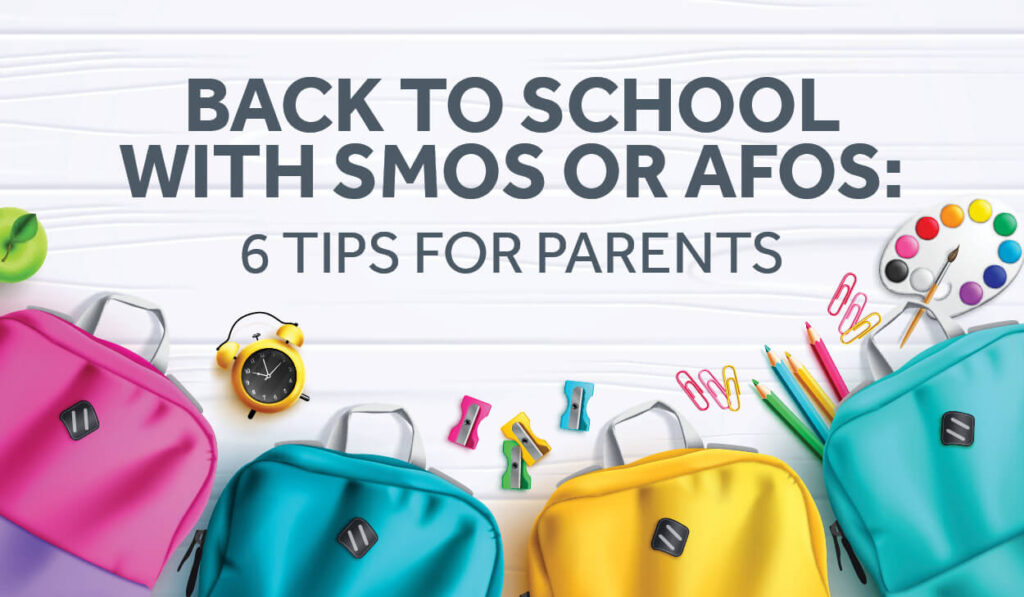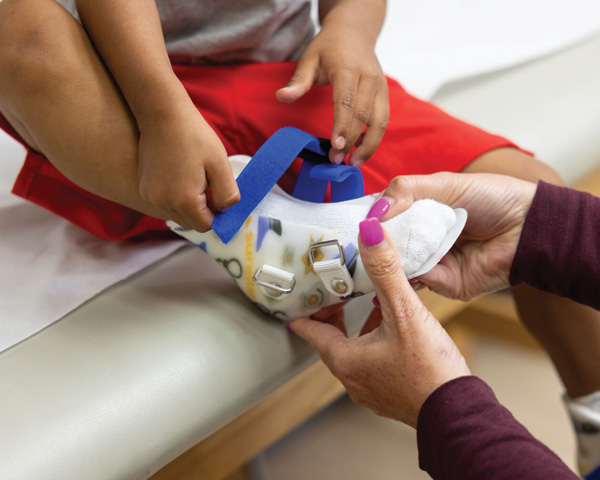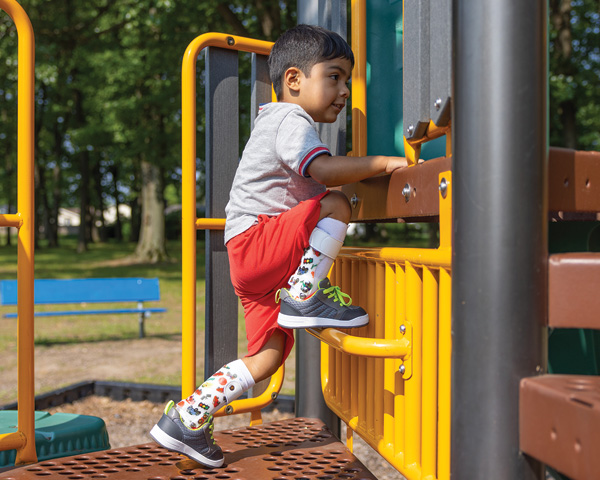10
Jul
2025
Back to School with SMOs or AFOs: 6 Tips for Parents
 “What challenges do parents have when sending kids with SMOs or AFOs back to school after summer break?”
“What challenges do parents have when sending kids with SMOs or AFOs back to school after summer break?”
Three of our Surestep educators—Anne, Camille, and Katie—have decades of combined experience as certified pediatric orthotists, and have helped plenty of parents during summer appointments before school restarts in August or September
To help your family feel prepared for the year ahead, they shared helpful back-to-school tips for you and your kids in six categories. Check them out:
We designed it for your baby’s comfort—and to be easy for parents to use. You can even open and close it with one hand while you’re holding your baby!
1. Schedule an Appointment with Your Orthotist
An appointment before school starts allows time for your orthotist to:
- Check how well the braces fit and adjust them
- Answer any questions or concerns you have
- Order a new pair, if needed
But schedule it sooner rather than later—even July isn’t too early!
Orthotist offices get busy in August and September. If your child has grown, new braces can take weeks to manufacture.
2. Break-in SMOs or AFOs Again

If your kiddo has worn braces a little less during the summer, what do you do?
In the weeks before school starts, gradually reintroduce braces to your child’s daily routine.
You can dig up the break-in schedule your local orthotist first gave you, if you need to.
Or make your own, starting with these guidelines:
- SMOs: Can be worn for 60 minutes at first when a child isn’t used to them
- AFOs: Try at first for only 30 minutes at a time
Then, bump the time periods up by an hour each day—or have more short sessions per day—to let their feet adjust.
Be sure to check their skin for irritation or blisters, too. Remember, to protect your child’s skin in general:
- Put quality socks on first
- Wrap braces over them, pulling straps to the recommended tightness
- Put brace-compatible shoes over them for balance, mobility, and safety
Some skin redness is a normal reaction to good, well-fit braces. But if you see a blister, bruises, or red or purple marks, give your child a break and call your orthotist for an adjustment.
3. Get School Staff Involved (and Educated!)
If your child is moving into a new classroom or school, make time to talk with their teacher and other caregivers. Here are a few resources and tips you can share:
- SMO or AFO Basics: Explain the purpose of the braces, the diagnosis they treat (often hypotonia), and how important they are to your child’s development. This might be the first time they’ve heard of them.
- Wear and Care Guides: We have guides for SMOs, AFOs, and TLSOs. Print copies for teachers to hold on to. You can also write your own notes on them and give them to the teacher.
- Left and Right Stickers: If someone is going to help your child take their braces off and put them back on, show them the “left” and “right” stickers on the braces. The shape of the trim lines can confuse first-time users.
- Zero-Worry Plastic: Share that our braces are designed for extreme flexibility. They won’t break easily. A caregiver shouldn’t be afraid to spread them open when putting them on your child. {donning video}
- Socks and Shoes: Tell them socks go on first, smoothed down so they’re free of wrinkles and bunching—very important to avoid skin irritation. Then, put braces and shoes over them, tightening until everything is snug.
Be patient! School staff will be on your child’s team for the long-term. They want what’s best for them, and will become more comfortable with AFO or SMO braces over time.
4. Recess and Gym Class

Most kids love recess, and yours might be starting a new gym class too. It may be helpful to talk to the P.E. teacher—or anyone else who needs tips about braces during playtime:
- Braces Stay On: A teacher might think braces will get in the way. But they’re even more important when a child is running and jumping! They help keep feet and ankles in alignment, improving your child’s development.
- Extra Socks: Your child could get sweaty—especially in hot weather—so pack some extra socks. If they need help changing them after playtime, tell caregivers that changing socks protects skin from irritation. Also, if your child has sensory concerns, clean socks can really improve the experience of wearing braces.
- Supportive Shoes: Snug, well-fitting shoes are an extension of SMOs or AFOs, helping your child reap their full benefits. (If you have trouble finding shoes that fit, check out our guide.)
If your kiddo needs any ideas on how to talk to other students who ask questions about braces, focus on what the braces let them do. “I love to run fast, and these help me.” “I love to run and play on the playground, and these braces help me not to fall as much.” Some of our patients have also called them “magic shoes” or “magic boots.”
5. Communication During the School Day
AFOs and SMOs might be new territory to your child’s educators. So, give them the best ways to reach you if they have any questions, and how soon they can expect an answer.
They’ll want to know what to do when your child has a problem—and how to detect it. The three orthotists told us this:
- Your Child’s Communication Style: Tell teachers how your child talks about their discomfort—if at all. Some kiddos don’t complain, or may be non-verbal.
- Daily Checks: Some children need teachers to take off their braces every daily and put them back on. That gives teachers a chance to check for skin irritation or blisters.
- Photos of Changes: If a child has a skin problem or other issue, the teacher or helper should take a picture of it right away. Sometimes, the condition gets better by the time the child gets home or visits the orthotist, so documenting changes is important.
- Consent for Photos: Anyone taking photos should follow the guidelines of their institution and have your consent.
If your school has a communication app, they can share photos, questions, and other messages with you directly. This will keep all of it in one handy place.
6. Encouraging Books
Some parents have written books about their children’s “magic shoes,” or orthotic braces. They’re perfect for helping kids understand braces.
Teachers could even read them in front of the class…or you could be a guest parent who reads a book to your child’s class.
Below are some examples to check out. (These are non-sponsored Amazon links, but feel free to find these in your own search engine.)
- Super Special Magic Shoes: A brightly illustrated story showing how SMOs and other braces help children run, jump, and play.
- Frankie’s New Shoes: Follow Frankie as she gets AFOs and learns to embrace them as part of herself.
- Brace Yourself for Another Day: See how Peaches discovers how her braces help her with muscular dystrophy.
- Daniel’s New Friend (Daniel Tiger’s Neighborhood): Based on a popular TV episode, Daniel befriends Chrissie, who wears leg braces and loves to play.
Empower Your Child and School Team
The goal of these tips is to empower your kiddo to keep growing and developing. With caring adult helpers and great-fitting SMOs or AFOs, your child will be able to focus on friends, play, and learning.
School staff want to help, but they need knowledge, resources, and your feedback. Be patient with them, and they’ll become a great part of your child’s team!
If you have your own tips, drop by our Facebook or Instagram pages to share them with our Surestep community!
Shop Surestep Shoes for Back to School